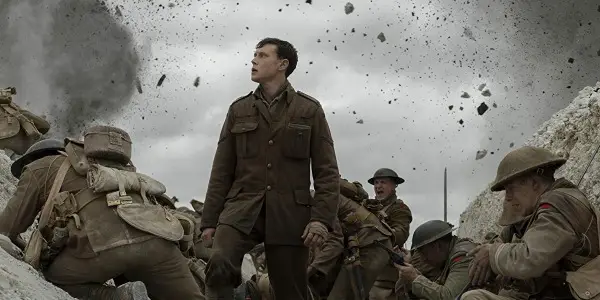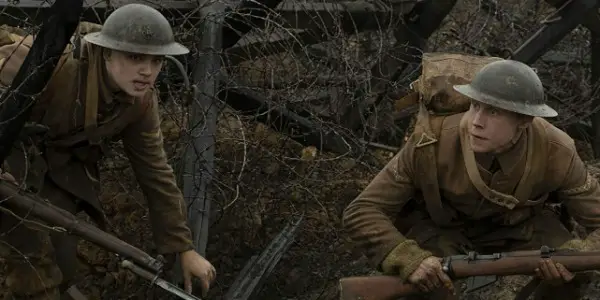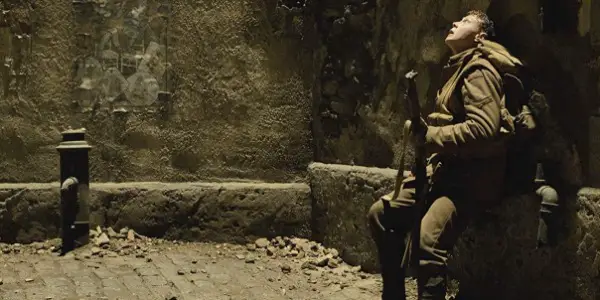1917: War Epic Blends Seamless Technical Work & Painful Emotion

I'm a student at the University of North Carolina at…
Every holiday season, there’s always one final big movie — usually a high-profile passion project by an A-list director — that squeaks in at the last minute to close out the year. This is undoubtedly for awards purposes in every instance (which are fairly irrelevant for this article), but it has the side effect of giving movie fans one last must-see before the January doldrums roll back around. This year’s blowout finale is Sam Mendes‘ 1917, the Oscar-winning director’s first movie since 2015’s Spectre and his first collaboration with iconic cinematographer Roger Deakins since 2012’s Skyfall. With that pedigree alone, it’s worth taking notice.
But 1917 has another headline-catching asset (or gimmick, depending on who you ask) working in its favor: it’s all designed to look like it was shot in one single, unbroken take. Of course, much like Birdman and other notable mainstream experiments, there are plenty of invisible edits — plus, with a significant, jarring break in the middle, I’d argue that the film is two unbroken takes, not one. Naturally, these minor details won’t stop the fluidity of Mendes‘ camera from being the principal talking point as 1917 screens for more and more critics, especially considering just how seamless the technical aspects become at a certain point. But 1917 only works because it’s more emotional and poignant than its clinical wizardry would lead you to believe — it’s horrific and brutal, yet also quite touching. It may not be the best war film of the last decade — we’ll get to that later — but it’s a unique experience that either won’t be replicated ever again or will soon become the future of the war film.
Mission to Stop a Massacre
1917‘s plot could not be simpler. It’s the height of World War I, and British forces are currently preparing for an attack on the German army. There’s one small problem: this upcoming attack is a trap. Miles away from where the trap is set to take place, Lance Corporal Blake (Dean-Charles Chapman) and Lance Corporal Schofield (George MacKay) are summoned to the dark, grimy office of General Erinmore (Colin Firth), who provides them with what might be the most important mission of the war. Blake has a brother in one of the neighboring battalions, and if the upcoming attack actually goes through, his brother will likely perish. As Erinmore says, it’ll be nothing short of a “massacre.”

Even with a simple mission, Schofield and Blake’s task is anything but simple. They must cross into enemy territory, which is believed to be abandoned — but still could be held by the Germans. Beyond that initial risk, they’ll need to brave the elements in the unforgiving trenches and in the horrific depths of No Man’s Land, where decomposing bodies, animals, and barbed wire provide new obstacles. And then there’s the question of time: with the clock ticking, will the two corporals be able to deliver the message to General MacKenzie (Benedict Cumberbatch) before it’s too late?
Technically Stunning One-Take War Saga
If Skyfall was Sam Mendes‘ gritty, politically charged response to Christopher Nolan‘s The Dark Knight, then 1917 is Mendes‘ response to Nolan‘s Dunkirk, even if they take place in completely different time periods. The two films are obviously aesthetically similar, filled with stark images that highlight the inhumanity of the whole gruesome experience (truth be told, I always forget that Nolan and Deakins have never worked together). But in a more significant fashion, 1917 and Dunkirk each represent a formal cinematic representation of an overarching philosophy of the experience of war. Dunkirk, with its reliance on competing temporal narratives and a focus on a particular kind of pulse-pounding montage, positions war as a disconnected journey, in which the duration of the experience can only be condensed into jarring, frightening fragments.

With its one-take gambit, 1917 positions war as continuous and unrelenting. Even when the characters are not in immediate danger, the camera never leaves their side, always tracking the lingering effects of violent chaos on the quiet moments of life. The smooth tracking shots are most effective when Schofield and Blake are in the trenches, swiftly ducking and moving around injured soldiers and other obstacles as they move with purpose to their destination. At other moments, the one-take style seems rather futile, like Mendes and Deakins just decided they had to stick with the gimmick even if it didn’t do much for the narrative.
Eventually, a curious thing happens: you pretty much stop noticing the lack of editing. Much like the experience of the de-aging effects in Martin Scorsese‘s The Irishman or the high frame rate work in Ang Lee‘s Gemini Man, the technology becomes a seamless part of the experience of watching 1917. In one respect, this is a good thing for the film — the story is arguably so involving that you’re no longer distracted by (or merely fixated on) the technology. In another regard, the ease with which we accept the single take as part of the film’s cinematic grammar raises an interesting question: why bother at all? Phrased in a different way, I don’t know if 1917‘s core formal innovation does a whole lot to enhance the story at hand. At a certain point, it’s just there. It’s clear and matter of fact in a way that I found impressive — and just a little amusing.
“Hope is a Dangerous Thing”
Whether the one-take approach is futile or brilliant, one thing is for certain: this is a technically stunning picture. Beyond the tracking shots, Deakins‘ dazzling blend of shadows, working within the confines of a film with a muted color palette, is never less than sensational. Thomas Newman‘s score — which contains a few much-appreciated shades of his work on Skyfall — is similarly terrific, working in a mode of low-key tension that veers into grandeur at different points. Perhaps most crucially, the film is never particularly violent, but always extraordinarily repulsive, highlighting the desolate brutality of World War I with unflinching clarity.

But 1917 is also a surprisingly emotional experience, albeit an understated and somewhat vague one. Several scenes avoid prompting visceral reactions and search for something more poignant in the mess of the war. The most powerful moment in what can only be described as an extraordinarily forceful film occurs in the underground ruins of a city, where a French woman is living with her baby. Even with the language barrier between Schofield and the woman, there’s a devastating bond between the three characters, a bond that makes even more sense when certain details are revealed later. Mendes observes this tender moment in all its beauty and terror; when Schofield leaves to continue his mission, the woman’s pleas for him to stay are utterly heartbreaking.
There’s also something fascinating about the general mood and political outlook of 1917, if we attempt to view these historical war films as commentary on the current moment. To return to the Dunkirk comparison, Nolan‘s film prioritized survival above all else — survival was the victory, overcoming the anonymous fascist forces that were fast approaching. Dunkirk is bleak, but it ends in defiance, with the promise of a victory in the future. 1917 does not contain that same promise; it’s a more fatalistic, less optimistic film. To put it in the words of General MacKenzie after the film’s climax: “Hope is a dangerous thing.” Even if Schofield and Blake can stop this failure, another loss is on the horizon. As a reflection of where we are in late 2019, it’s telling.
1917: Conclusion
As a clever cinematic remix of the war film, 1917 is destined to be greeted by a good deal of hyperbole in the coming months. As always, it’s worth being wary of that. But even if it doesn’t quite rise to any kind of all-time masterpiece status, Mendes‘ latest is a strong technical exercise that grows even more impressive when you consider just how moving it can be. Mendes and Deakins present a vision of uninterrupted chaos, equipped with a unique blend of personal pathos and visual bravado. Its cumulative impact is undeniable.
What did you think of 1917? What is your favorite war movie of all time? Let us know in the comments below!
1917 will be released in theaters on December 25, 2019 in the US and on January 10, 2020 in the UK. For all international release dates, click here.
Does content like this matter to you?
Become a Member and support film journalism. Unlock access to all of Film Inquiry`s great articles. Join a community of like-minded readers who are passionate about cinema - get access to our private members Network, give back to independent filmmakers, and more.
I'm a student at the University of North Carolina at Chapel Hill. For 8 years, I've edited the blog Martin on Movies. This is where I review new releases, cover new trailers, and discuss important news in the entertainment industry. Some of my favorite movies- Casablanca, Inception, Singin' in the Rain, 2001: A Space Odyssey, The Wolf of Wall Street, The Nice Guys, La La Land, Airplane!, Skyfall, Raiders of the Lost Ark. You can find my other reviews and articles at Martin on Movies (http://martinonmovies.blogspot.com/).













